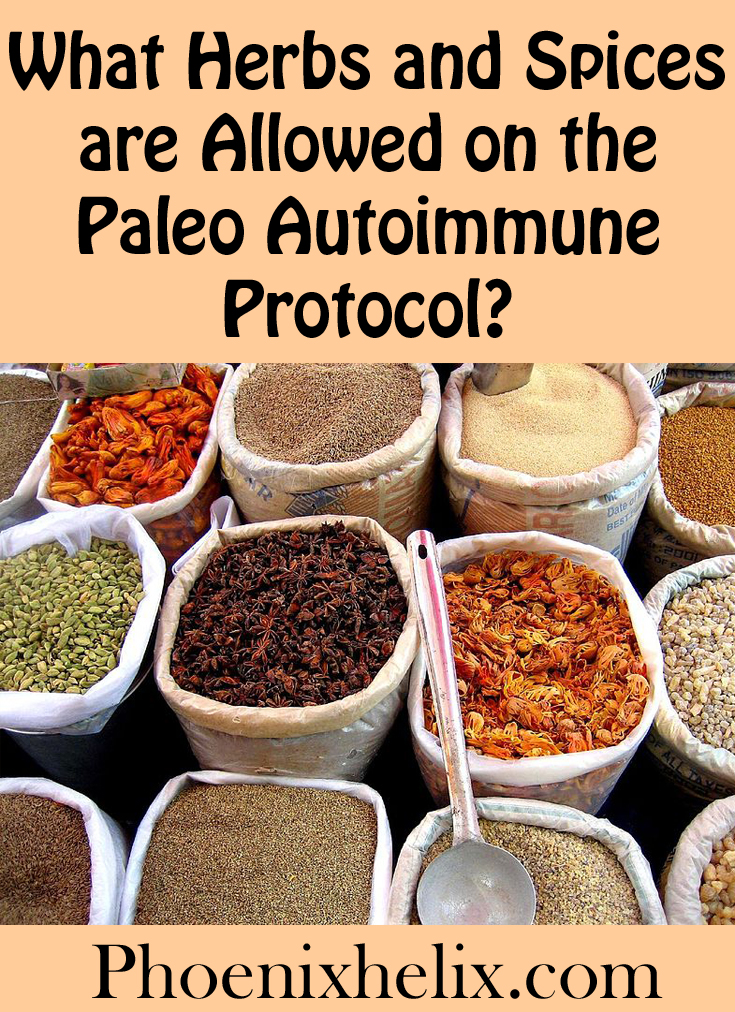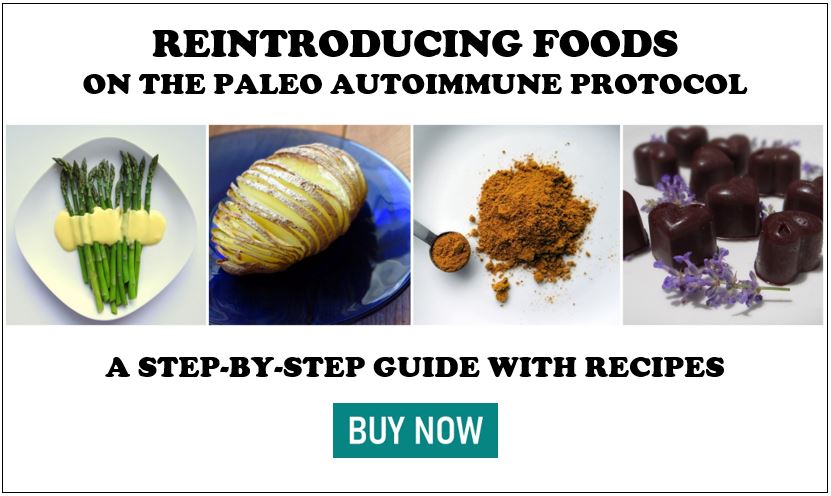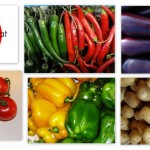
“Oh, better no doubt is a dinner of herbs,
When season’d with love, which no rancour disturbs
And sweeten’d by all that is sweetest in life.”
~ Edward Bulwer-Lytton
What Herbs and Spices are Allowed on the Paleo Autoimmune Protocol (AIP)?
| Basil Leaf Bay Leaf Chamomile Chervil Chives Cilantro Cinnamon Cloves Curry Leaf (not the powdered curry blend) Dill Weed Fennel Leaf Fenugreek Leaves Galangal Garlic Ginger Horseradish Kaffir Lime Leaf Lavender Lemon Balm Lemongrass |
Mace Marjoram Leaf Onion Powder Oregano Leaf Parsley Peppermint Rosemary Saffron Sage Savory Leaf Sea Salt Shallots Spearmint Tarragon Thyme Truffle Salt Turmeric Vanilla (alcohol-free only) Wasabi (additive-free) |
Why the Confusion Between Blogs and Books?
The AIP is an evolving protocol. What started as a few general recommendations from Loren Cordain and Robb Wolf (to avoid eggs and nightshades), expanded into a complete protocol contained in the book, The Paleo Approach by Sarah Ballantyne, and summarized here. She spent years delving into the scientific research to determine what foods might be inflammation triggers for people with autoimmune disease. Unfortunately, many spices made the list. She separates them into 4 categories:
- Safe Spices (Leaves, Flowers, Roots and Barks) – listed above.
- Mild Caution Spices (Fruits and Berries)
- Moderate Caution Spices (Seeds)
- High Caution Spices (Nightshades)
Originally the “mild caution” spices were considered optional exclusions. These included things like black pepper, so many AIP bloggers continued to include them in their recipes. However, with the publication of The Paleo Approach, she moved all the cautions onto the “foods to avoid” list. She didn’t want to sabotage anyone’s healing by allowing foods on the protocol that had the potential to increase inflammation. All of the Paleo Approach Approved bloggers are aware of the change, and you can trust their recipes to be strict AIP. If you find AIP-labeled recipes on other blogs or books that include forbidden spices, it’s simply because those recipe authors haven’t stayed up-to-date with the protocol.
The good news is that Strict AIP isn’t meant to last forever. Fruit and seed-based spices are among the first foods to try reintroducing, after completing your elimination period. In the meantime, experiment with the safe herbs and spices listed above, and keep reading for lots of great ways to add flavor to your recipes.
How Can I Add Heat to My Recipes?
Losing both nightshade spices (cayenne, chili, paprika, curry blends) and fruit-based spices (which contain peppercorns) can be a huge blow, especially if we love fiery flavors. But all is not lost. The AIP is a chance to explore new flavors, and some of them deliver heat as well:
- Fresh ginger: This is one of my favorites, and if you add a lot of it to a dish, it will bring heat along with it. The key is to grate it very finely, and there are two ways to do this. One is to use a ceramic grater designed for grating fresh ginger. The other is to freeze your ginger, and use a microplane to zest it.
- Horseradish: This is one of my husband’s favorite flavors. Storebought brands, unfortunately, contain additives. However, it’s pretty easy to make your own.
- Wasabi: This is another AIP-friendly hot condiment, but check ingredient labels carefully. Storebought brands are usually full of ingredients not allowed on the AIP. Sushi Sonic is pure freeze-dried wasabi. Just add water.
- Garlic: In addition to its classic flavor, garlic can add a kick to a meal. The finer the mince, the more intense the heat, especially if you smash the clove first. So practice your knife skills. Bonus Tip: If you heat garlic immediately after mincing, it destroys its ability to produce allicin (the healing compound in garlic). However, if you mince your garlic and wait 10 minutes before cooking with it, plenty of allicin is created, and it’s not destroyed by heat. Garlic cooks fast, though, so watch it closely. Burnt garlic tastes bitter.
What Are Other Ways to Add Flavor?
- Be generous with herbs. Experiment with using far more than you’d ever imagine. They each have their own health benefits and can be incredibly flavorful.
- Try these AIP-friendly spice blends: (1) Herbamare Seasoned Salt. (2) Primal Palate AIP Spice Blends. (3) Truly AIP Taco Seasoning & Ranch Mix. (4) KC Natural BBQ Rub. You can find them all through ShopAIP.
- There are two sauces you’ll want in your pantry: coconut aminos and fish sauce. The coconut aminos add a sweet-savory flavor to a dish, and is often used as a substitute for soy sauce in stir fries. The fish sauce adds a salty-savory flavor, and a little bit goes a long way, so often just a tablespoon is added to boost the flavor of a recipe. Bonus Tip: Kat at The Primordial Table combines coconut aminos and fish sauce 50/50 and says it’s a much closer substitute for soy sauce than coconut aminos alone.
- Have fun with vinegar: Most of us are used to the basic vinegars: balsamic, wine, and apple cider vinegar. And they’re wonderful! But there’s a world of vinegar out there, and each one imparts its own flavor. I can recommend two to try: sherry and ume plum. A note on the ume plum vinegar: Dora, former blogger at Provincial Paleo calls it sweet, salty and sour at the same time. When you experiment with it, start with small quantities and remove the salt from your recipe. Soon, you may be in love with a new condiment. Bonus Tip: If you brew kombucha, try brewing it 30 days to make kombucha vinegar and experiment with that in your salad dressings and other recipes.
- Try some AIP condiment recipes: I’ve rounded up 50 for you, everything from mayonnaise to ketchup to salsa to salad dressings. And KC Natural is a store-bought brand of AIP condiments and sauces.
- Enjoy an AIP curry: In my recipe for Curried Chicken and “Rice” Stew, I have two options for nightshade-free curry blends. One is strict AIP. The other is a good choice when you’re ready to reintroduce seed-based spices.
When It Comes to Reintroducing Spices, Where Do I Start?
Reintroduce fruit-based spices first. If that goes well, reintroduce seed-based spices. They are both considered stage one reintroductions, and many people with autoimmune disease find they tolerate them very well. Nightshade spices are a different story; it’s rare (although not impossible) to tolerate them. For that reason, they’re a stage four reintroduction: one of the last foods recommended to reintroduce. You can find the list of spices in each category on Sarah Ballantyne’s website, in her book The Paleo Approach, or in my guide Reintroducing Foods on the AIP. When you reintroduce an individual spice, or a blend within a spice category, just add it to your recipe and then the recipe itself becomes the reintroduced food. Black pepper is the easiest spice to reintroduce, because you can just sprinkle it on your meal at the table.
You May Also Be Interested In
Credit: image at top of page from Wikimedia.











Hi there! Thank you so much for all the helpful information you provide. Maybe this is a silly question, but I’m just getting ready to start the reintroduction phase, and I’m a bit confused about the process. If I start with a fruit based spice, such as black pepper, once I’ve done the trial and waited an appropriate length of time and (hopefully) have had no reaction, does that imply that I can reintroduce all fruit based spices just from trying black pepper? Or do I have to reintroduce each fruit based spice individually on its own? I hope this question makes sense! I feel like the answer must be totally oblivious because I’ve read countless posts about reintroduction, and I never see anyone specify. 😀 My instinct is that a trial with one spice, makes it reasonable to reintroduce that whole category. Otherwise, it’ll take decades to reintroduce everything, right?! Thanks for any insight you can offer!
Hi Emily. This is a challenging choice, for exactly the reason you describe. It is possible to be intolerant to just one spice within a category, but testing them individually can take a long time. When I reintroduced spices, I made some recipes that included spice blends. For example, I made a homemade curry powder that included black pepper, cumin, coriander, and mustard (which is a combination of fruit and seed-based spices.) It went well for me (no negative reaction). If I had experienced a negative reaction, I would have waited until my symptoms passed and reintroduced each one separately again, to try to find the exact one my body didn’t like. So, that’s one way you can try to speed up the process. Other people are more patient than me and reintroduce just one spice at a time. The choice is yours! Note: when it comes to other food reintroductions, I don’t recommend doing this blended technique. For example, when it comes to nightshade vegetables, reintroduce them one at a time. Best wishes with your reintros!
Thank you! That’s helpful and makes total sense. I think that’ll be my approach. 🙂
Any help on whether or not these ingredients would be AIP friendly…
– Chaga Extract
– Rose Hips Extract
– Eleuthero Extract
Its Four Sigmatic Chaga Elixir. Since going AIP and cutting out coffee) for about -6 weeks now I was going to add this back as a replacement and bulletproof it with coconut oil … I just wasn’t sure about the extracts, I looked up the roots and they dont seem to be nightshades of any kind
Any help/guidance would be greatly appreciated
Hi Mark. Whenever you’re looking at medicinal herbs, do a google search regarding their benefits. If one of their benefits is to boost the immune system, those are best avoided during the elimination phase of the AIP. This is because anything that boosts the immune system can increase autoimmune activity. Once you start the reintroduction process, you can try reintroducing the herb at that time and see the effect on your body: positive, negative, or neutral. Everyone’s response will be unique. But during the elimination phase, you don’t want to muddy the waters. I googled the first ingredient – Chaga – and it’s immune boosting, so that tea is best avoided. If you’re looking for a replacement for coffee, here are two options: AIP Bulletproof “Coffee” or Turmeric Latte.
is glycerin allowed in this diet
Hi Cathy. Glycerin tends to be derived from corn, so it’s best avoided during the elimination phase of the AIP.
Thank you. I fell of the wagon, so I have to start over again. One of the supplements I am taking had some ingredients, that are not allowed in the AIP. I did not know because they were not listed in the label. I found out because I called the company. I was mad at first, but staying mad is worse for the immune system then taking the supplements. I will start over again after Easter. I don’t have a hard time following this protocol because I was not eating a lot of the foods that are not allowed in the AIP. I have not desire for sugar, grains, dairy, the only think I missed was the one cup of coffee I was drinking twice a week. Your recipes are great!
Hi Eileen,
thank you for your fast comment!
It’s a good point with the stimulation of the immune system, that is something I did’t look at so far. Before I only paid attention to nuts, seeds and nightshades.
I hope I will find information whether a herb stimulates the immune system, because I don’t know how to judge a new symptom – I take the herbs for Lyme disease, so any reaction could also be because of the die-off of the pathogens. Difficult…
Hi Eileen, I just wonder how medicinal herbs are considered. For example the whole herb – I don’t know if this can contain flowers and seeds. Currently I’m interested in Cistus incanus.
Hi Susie, since I’m neither an herbalist nor a doctor, I can’t give specific advice. But the general recommendation in the AIP community is to avoid medicinal herbs which stimulate the immune system, as they can cause flares in people with autoimmune disease. If you choose to experiment with such herbs, keep a symptom journal and control other variables in your diet and your life, so you can see clearly the impact of that specific herb – positive, negative, or neutral.
Any insight on whether or not the Chai Spices in a Third Eye Chai Kombucha would be ok on AIP?
Chai contains seed-based spices, Mark, unless it’s a special homemade AIP-friendly blend. So, that means any packaged product with chai spices isn’t AIP. However, it’s good to get in the habit of simply checking labels, so you can answer this question on any product you’re wondering about. Any spices on the label that are NOT on the yes list above aren’t AIP. If a company simply says “spices” you’ll have to contact the company to find out what that entails. When you’re ready for reintroductions, seed-based spices are considered stage 1 reintroductions and many people reintroduce them successfully at that time.
Thank you so much for your reply Eileen, you are such a great help in this journey!
Hi Eileen!
I’ve noticed my body reacts to ground seed-based spices differently (worse) than to whole seed-based spices. For example, I do notice an effect with ground cumin, but I notice much less effect if I cook with while cumin seed & remove it before eating. Do you have any insight into this? Is this a safer way to use the spice?
Trust your body, Lucy. Everyone’s different. It sounds like you have found the right way to reintroduce the seedbased spices for you. Enjoy!
Shouldn’t Garlic be an “avoid” food for people with overactive immune systems (Lupus/SLE, MCTD), since it stimulates the immune system?
Hi Clint. You don’t need to worry about garlic as a whole food. It’s not concentrated enough to overstimulate. You might want to be careful with concentrated garlic supplements, however.
Hey there! You mention that real wasabi is AIP approved, but are you aware that the wasabi powder that you have linked has answered “questions” that contradict themselves as to whether or not the product is 100% real wasabi? I would love to get a safe wasabi product.
Hi Samantha. I doublechecked the listing and it is 100% wasabi. It could be that a buyer was shipped the wrong product, hence the confusion. But I know many people who use this. Just doublecheck the ingredients upon receipt.
Thanks for the list – I somehow missed this when you first posted it.
One other herb that as far as I can see is allowed on AIP (but is not mentioned above) is Fenugreek leaves (Kasuri Methi). They are used in Indian cooking, often sprinkled over curries and seem to have a beneficial effect on the digestion and liver function from everything that I have read.
The fresh leaves are also sometimes cooked as a green vegetable as well.
Thanks, Charlotte! I added it to the list.
Hello. Love your site. I’ve been gluten and dairy free for years, tried paleo, and have slacked off for about a year and eaten grains and legumes. Anyways, last year I ate too much kale and cabbage and sauerkraut. Now I get terrible stomach aches when I eat any of those and even horseradish. I think I will re-do the elimination diet and test them again in a few months. However, I was wondering if you’ve heard of this sensitivity happening? It’s so sad because I love horseradish, kale and sauerkraut. I tend to avoid other cruciferous vegetables now, too. 🙁
Hi Natalie. The Paleo PI wrote a great article series on sulfur sensitivity. The important thing is getting to the root of the problem, so that you don’t avoid these foods forever. Read these articles for more information: Part 1 and Part 2
Ooooh, wow! That is some crazy stuff. Thanks for the link!
Hello Eileen,
are you sure about the curry leaves? Because I haven’t found anything about them on the Paleo Mom Website. I am wondering because I need an iron-supplement and I found one that is with Iron that gets extracted from the curry leaf. I’m not sure whether I can take it or not. The iron supplement that was prescribed to me by my functional doctor has potato starch and rice starch so I worry if I can really take that one. Any ideas?
Yes, I’m sure Susann. Curry powder isn’t allowed on the AIP because it contains nightshade & seedbased spices (unless you make your own recipe). Curry leaves are totally different and aren’t actually an ingredient in curry powder at all. My blog is always in alignment with The Paleo Mom, which is why I have the Paleo Approach Approved badge in my sidebar. It verifies that I know the AIP inside and out. 🙂 Do you have The Paleo Mom’s cookbook? If yes, she has a Yes/No list in the resource section. Here’s a link to it online. If you scroll down a few pages, you’ll see curry leaves on the yes list: http://www.thepaleomom.com/wp-content/uploads/2014/08/Yes-No-Maybe-So-List.pdf
Thank you for the fast and very helpful response! 🙂
I have a question about vanilla. The alcohol free vanilla extract often contains glycerin. I know some vegetable glycerin is made of palm, but I have a feeling I have read it sometimes is made of corn too? And is ground pure vanilla out of the question? I have been using that as I felt the extracts always have an added ingredient. Thanks, this is a great post!
Hi Sirpa. Yes, ground vanilla powder is fine!
Thanks!
Couldn’t the same thing be said of peppercorns? They are a whole fruit that is just ground up. I’ve been on the aip for quite awhile now, but I’m quite confused about vanilla. I would love to use it, but as I said, I don’t quite understand how it is different from other spices with seeds.
Sarah, that’s a fair question and to be perfectly honest, vanilla is the most confusing spice for me on the AIP also. Sarah Ballantyne is in charge of the protocol, so I defer to her. That said, almost everyone I know reintroduces vanilla with no problem. So, if you’ve been on the AIP for over 30 days, I think it’s fine to try vanilla in whatever form you prefer and just pay attention to make sure your body doesn’t react negatively. Also, regular alcohol-based vanilla extract is OK if it’s a cooked recipe, since the alcohol burns off in cooking.
Thanks for the reply. I guess I’ll stick to the extract for now to be safe:-)
Love the info you provided here. Thank you for breaking down the list of spices. I am excited to try mixing fish sauce and coconut aminos, I have never heard of that suggestion!
I love learning tricks from fellow AIP cooks!
Thank you so much Eileen!!
You’re welcome! 🙂
Love this. I’d also LOVE a post or podcast on any AIP legal convenience foods that exist. It is such a bummer to never ever ever be able to eat anything at all that I haven’t prepared myself. Darn everyone & their love of paprika! 🙂
I couldn’t agree more! Thankfully there are starting to be some convenience foods now, and I’ve linked to them in my blog store.